 Girls studying at Balika Shivir in Lunkaransar, Bikaner district, Rajasthan .[Photo: Bernice Wong Plan RCS report]
Girls studying at Balika Shivir in Lunkaransar, Bikaner district, Rajasthan .[Photo: Bernice Wong Plan RCS report]
[This is an excerpt from an article appearing in the current edition of The Round Table: The Commonwealth Journal of International Affairs.]
Priority Actions for Achieving 12 Years of Quality Education for All Girls
Based on the identification of barriers and what is already known to work to improve education of marginalised girls, we identify three key areas that Heads of Government need to pay attention to in order to accelerate progress towards 12 years of quality education for all girls.
Visible Political Leadership
A lack of visible political commitment has often meant inadequate legal and financial commitments to gender equality and girls’ education. Insufficient resources being allocated to girls’ education together with existing weak accountability relationships between citizens, the government and education providers, has led to an inability to mobilise action for girls’ education.
Tackling the education deficit for girls in Commonwealth countries will therefore require high-level, visible political leadership that promotes education planning and adopts a gender equality and empowerment lens and commits sufficient resources to reach the most marginalised girls. There is evidence that a focus on gender equality throughout policy and programming helps to ensure commitments are put into action. Furthermore, existing laws on girls’ education have been found to be effective where they are supported by enabling policies and strategies to promote their implementation, requiring governments to commit to promoting their efficacy and to change and update harmful laws and policies which restrict girls’ education. Moreover, when implemented effectively, gender-responsive budgeting has been found to impact positively on policy and practice.
Investing in Early Years’ Education
There is clear evidence on the importance of early childhood education for school readiness for all children, as well as benefits for later life. Early childhood education can influence girls’ retention and learning in the long term. However, economic and socio-cultural barriers to education of girls, especially those in marginalised groups, begin in early childhood and make them less likely to access early childhood education.
Therefore, there is a need to tackle barriers to education for marginalised girls in the very early years before they become entrenched. Some countries have done this by providing schools within the community in the early years to not only help girls to access education, but also to increase their learning, as well as by introducing complementary education programmes which have been able to reach girls who drop out of the formal system early.
Whilst the potential for such initiatives to tackle these barriers exists, very few domestic and aid resources are spent on the early years of education where disadvantage for marginalised girls starts. The tendency for education aid to not prioritise the early years nor show a consistent commitment to gender in its spending represents a missed opportunity to help ensure the majority of the most disadvantaged girls in many low- and lower-middle income Commonwealth countries make it at least to the end of primary school. Moving forward, therefore, there is a need for higher priority in domestic and international financing for girls’ early years education.
Making Girls’ Education a National Development Priority
Tackling the education deficit for girls will require that it become a national development priority. This will require fully concerted efforts inclusive of anchoring gender-inclusive education strategies in wider national development planning as well as cross-sectoral collaboration to tackle socio-cultural barriers and discrimination. More specifically, barriers related to gender-based violence, sexual and reproductive health, girls’ unpaid work, and limited productive employment opportunities will need to be addressed.
A girl-friendly school environment can make a difference to girls’ enrolment whereas a lack of safe school environments for girls, reinforced by insufficient school infrastructure, can limit access and learning for girls. Girls face additional barriers to both access and learning due to vulnerability to gender-based violence during travel to school and in school. Ensuring that schools are thus safe environments for girls, inclusive of whole-school and community efforts to target school-related gender-based violence, is therefore imperative. Additionally, considering that inequitable classroom environments impede girls’ ability to learn from the early years, efforts to eliminate discrimination by teachers, as well as curricula and materials that perpetuate gender biases and stereotypes restrict girls’ learning, will also be necessary.
If girls’ education is to become a national development priority then it will be necessary to tackle these economic and socio-cultural barriers through cross-sectoral reforms. Moreover, challenging entrenched ideas about the role of women in society and beliefs about the value of girls’ education will be imperative if the economic disadvantages which act as a pervasive barrier to their education as a result, are to be eliminated. One way to do this is to increase girls’ and women in local leadership which has been found to be influential in changing community attitudes and aspirations for girls’ education across the life course.
Furthermore, a lack of employment opportunities for women can lead to lower perceived benefits of girls’ education. Hence, in order to help girls to see the value of an education and to consequently influence their enrolment and learning, it will be important to tackle gender-based discrimination in the labour market.
Rebecca Gordon, Lauren Marston, Pauline Rose & Asma Zubairi are with Research for Equitable Access and Learning (REAL) Centre, Faculty of Education, University of Cambridge.



